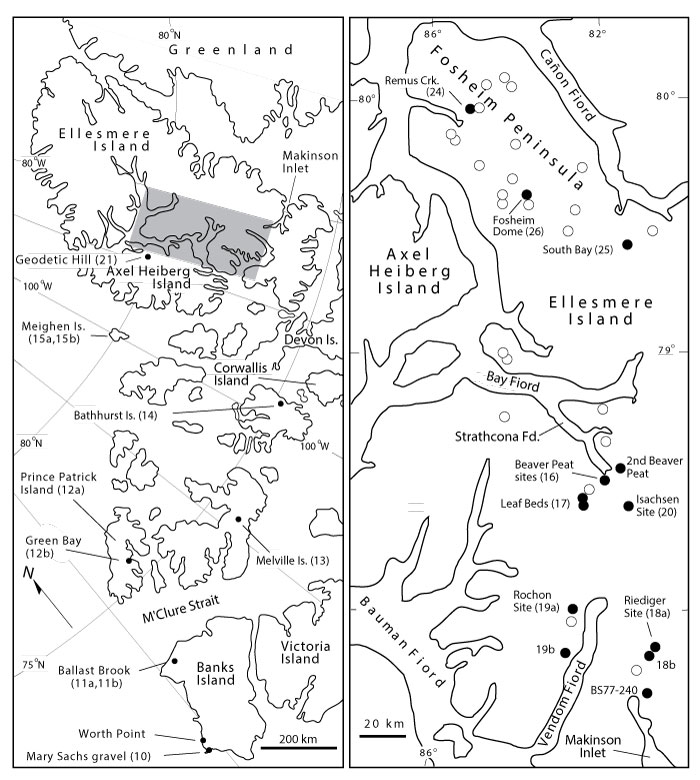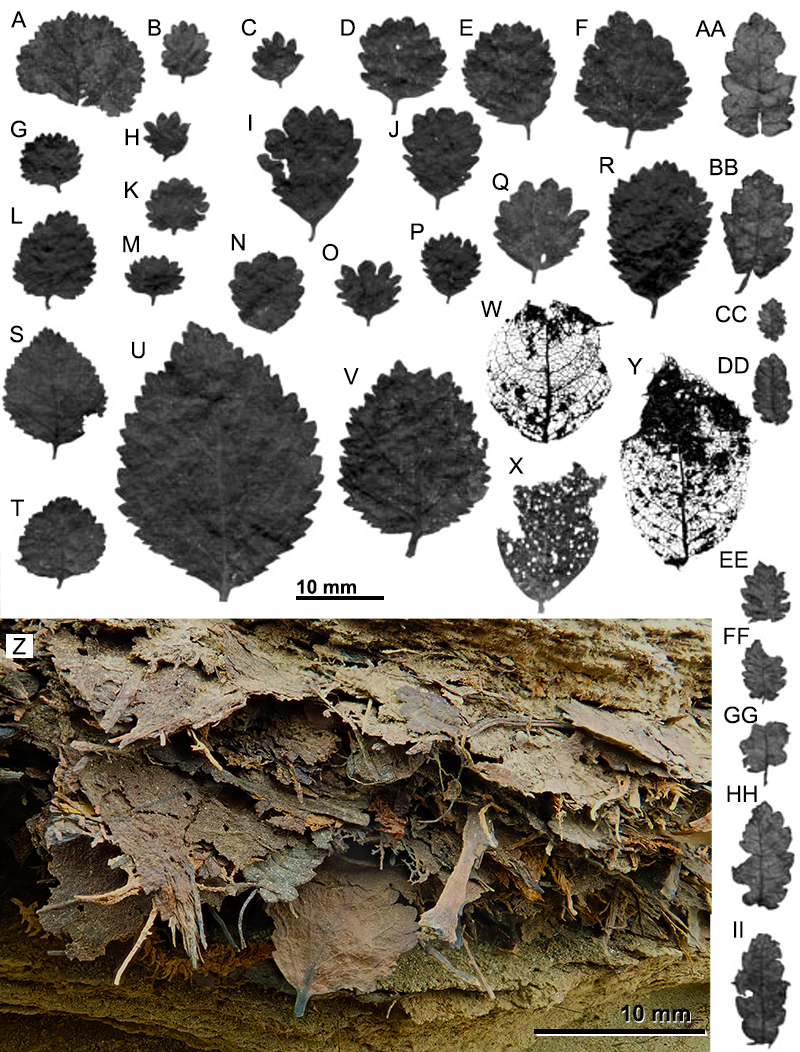FIGURE 1. Distribution of sites and geographical features mentioned in the text. Siberian localities are from Baranova and Biske (1979). Shaded areas are shown in greater detail in Figure 2 and Figure 4. Numbers refer to site codes used in Appendix 1 and throughout this paper.

FIGURE 2. Detailed site location maps of sites from interior Alaska and the Yukon. Numbers beside sites refer to site codes used in Appendix 1 and throughout this paper.

FIGURE 3. SEM micrographs of Epipremnum from Banks Island. (A) Epipremnum seed, external view, Ballast Brook, “lower Beaufort Lignite”, GSC 108847; (B) Epipremnum seed, internal view, Ballast Brook Formation, lower member, Sample 2, GSC 141420.

FIGURE 4. Detailed site location maps of sites from the western islands of the Canadian Arctic Archipelago, Canada. Shaded area on map at left indicates the region covered in the map at the right (note rotation). Numbers beside sites refer to site codes used in Appendix 1 and throughout this paper. Un-numbered circles represent Neogene to Early Quaternary sites from which plant and/or arthropod fossils have been isolated.

FIGURE 5. SEM micrographs of selected plant macrofossils from Mary Sachs gravel at Duck Hawk Bluffs, southern Banks Island. (A) Microdiptera/Mneme type (Lythraceae), seed, cross-section with germination valve to top, sample MRA 7-18-91-3, GSC 141399; note the absence of obvious dorsal furrows as seen on specimen from the Ballast Brook Formation (Fyles et al., 1994). Germination valve contains approximately ten rows of pits; (B) Parthenocissus? (Vitaceae), half of seed, ventral face showing one ventral infold, sample MRA 7-1-88-2, GSC 141400; (C) Microdiptera/Mneme type (Lythraceae), two joined seeds, ventral view with apex up, sample MRA 7-18-91-3, GSC 141401; note that the specimen on the right contains a fold on the wing, undoubtedly due to packing of the seeds in the capsule. This indicates how one of the characters used to distinguish Microdiptera from Mneme, relative development of the ‘wings’ is likely due to considerable variation even in seeds from the same plant and supports Tiffneyʼs (1981) conclusion about the dubious validity of the many named species; (D) Orchidaceae?, seed, sample FG 91-13a, GSC 141402; (E) Nigrella sp. (Melastomaceae), seed, from the site 3 type section of the Ballast Brook Formation (see Fyles et al. 1994), GSC 141421.

FIGURE 6. SEM micrographs of selected plant macrofossils from the Neogene on the Canadian Arctic Archipelago. (A) Rubus sp. (Rosaceae), seed, Mary Sachs gravel, sample MRA 7-7-88-1, GSC 141422; (B) Ludwigia sp. (Onagraceae), seed, Mary Sachs gravel, sample FG 91-13a, GSC 141403; (C) Verbena sp. (Verbenaceae), seed, Prince Patrick Island, NWT, Beaufort Formation, GSC 141404; (D) Unknown seed; Beaver Pond, Ellesmere Island, Nunavut, sample FG 88-8b, GSC 141405; (E) Cross-section of seed of the same type as shown in D, Beaver Pond, sample FG 88-8b, GSC 141406.

FIGURE 7. SEM micrographs of selected plant macrofossils from Mary Sachs gravel at Duck Hawk Bluffs, southern Banks Island, NWT. (A) Saxifraga sp. (Saxifragaceae), seed, sample FG 91-13a, GSC 141407; (B) Hydrangea?, sample FG 91-13a, GSC 141408; (C) Morus sp. (Moraceae), seed, sample MRA 7-23-85-2, GSC 141409; (D) Physalis sp. (Solanaceae), seed, sample MRA 7-7-88-3, GSC 141412; note in magnified view of the seed the pits in the lumina which distinguish Physalis from Solanum (Mai and Walther, 1988); (E) Teucrium sp. (Lamiaceae), seed, sample MRA 7-18-91-3, GSC 141413.

FIGURE 8. Selected leaf fossils from the Fyles Leaf Beds site (17), Ellesmere Island, Nunavut. Scale bar equals 10 mm. (A-V) Betula spp. (Betulaceae). Note the diversity of types ranging from some similar to those from the dwarf shrub species, B. nana (e.g., D, G, O, Q), contrasted with others (e.g., S, U, V) which are more typical of high shrub and tree species of Betula; (W) Skeletonized leaf of Salix, very similar to the type seen in S. reticulata (Salicaceae). (X) Fragment of Vaccinium sp. (Ericaceae) leaf showing peculiar circular perforations; (Y) Skeletonized leaf of Salix sp. (Salicaceae); (Z) Photograph of leaves in situ in the alternating sand and organic layers of Fyles Leaf Beds. (AA-II) Dryas cf. octopetala type (Rosaceae).

FIGURE 9. SEM micrographs of selected plant fossils from Neogene deposits in the high terrace sections on Ellesmere Island, and Beaufort Formation, Meighen Island. (A) cf. Tubela (Betulaceae), seed, Riediger site, Ellesmere Island, Nunavut, sample FG 89-28a, GSC 141414; a specimen very similar to this one was dissected and found to contain an Alnus-type seed like those referred to A. tertiaria in Matthews, 1987; (B) Picea mariana/rubra type (Pinaceae), cross-section of needle showing resin canals (arrows), Beaver Peat, Ellesmere Island, Nunavut, sample FG-88-51b, GSC 141415; (C) Thesium? (Santalaceae), seed, Prince Patrick Island, NWT, Green Bay beds, sample FG 87-10a/2, GSC 141416; (D) Calla sp. (Araceae), seed, Beaver Pond, Ellesmere Island, Nunavut, FG 88-8b, GSC 141417; (E) Unknown seed, Beaver Pond, Ellesmere Island, Nunavut, FG-88-8b, GSC 141418; (F) Comptonia sp. (Myricaceae), seed, Meighen Island, Nunavut, sample MRA 7-25-75-5, GSC 141419.

FIGURE 10. Correlation diagram. See text for details. Black circles and sites in bold face are independently dated. Note scale change in the Miocene part of the table. Double pointed arrows indicate possible age range of the site. Shaded column between certain sets indicates sites in stratigraphic superposition. Grey dotted line (10) indicates that although the flora appears mid-Miocene, the flora and surrounding sediment may have been redeposited much later. (1) Lava Camp mine, western Alaska (5.9 Ma); (2) Lost Chicken mine, east central Alaska (2.9 Ma); (3) Nigua- nak site, northern Alaska; (4) Cone Bluff, Porcupine River, east central Alaska; (5) Canyon Village section, Porcupine River, east central Alaska (6.4 Ma, late Miocene); (6) Upper Ramparts site, Porcupine River, east central Alaska (16 Ma); (7) Circle Gravels, east central Alaska (early Pliocene); (8a and 8b) Chʼijeeʼs Bluff, Unit 1 (8a) and Unit 2 (8b), northern Yukon; (9a and 9b) Bluefish Section, northern Yukon; (10) Mary Sachs gravel, southern Banks Island, NWT; (11a and 11b) Ballast Brook Formation (11a) and Beaufort Formation (11b) at Ballast Brook, northern Banks Island, NWT; (12a and 12b) Prince Patrick Island, NWT; typical Beaufort deposits from many sites on the island (12a) and Green Bay beds (12b); (13) Melville Island, NWT; Beaufort Formation; (14) Bathurst Island, Nunavut; Beaufort Formation; (15a and 15b) Meighen Island, Nunavut; deposits below (15a) and above (15b) the approximately 3 Ma marine unit within the Beaufort Formation; (16) Beaver Pond locality, Strathcona Fiord, Ellesmere Island, Nunavut (3.9 Ma); (17) Fyles Leaf beds site near the Beaver Pond locality at Strathcona Fiord, Ellesmere Island, NWT (3.8 Ma); (18a) Riediger Site, Ellesmere Island, NWT; (18b) Site within 2 km of Riediger Site, Ellesmere Island, Nunavut; (19a) Rochon Site, Vendom Fiord region, Ellesmere Island, Nunavut; (19b) Typical high terrace sediments near the Rochon site on Vendom Fiord, Ellesmere Island, Nunavut; (20) Isachsen Site near the head of Makinson Inlet, Elles- mere Island, Nunavut; (21) Capping gravels and sands at Geodetic Hills Eocene locality, Axel Heiberg Island, Nun- avut; (22) West River site near Horton River upland, northern mainland, coast, NWT; (23) Plateau Cap gravels, Horton upland, northern mainland coast, NWT; (24) Remus Creek site, Fosheim Peninsula, Ellesmere Island, NWT; (25) South Bay site, Fosheim Peninsula, Ellesmere Island, Nunavut; (26) Fosheim Dome, Fosheim Peninsula, Ellesmere Island, Nunavut.


